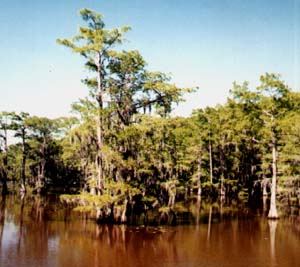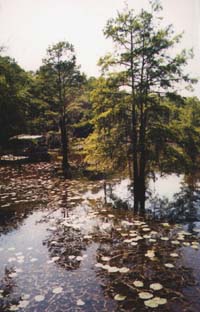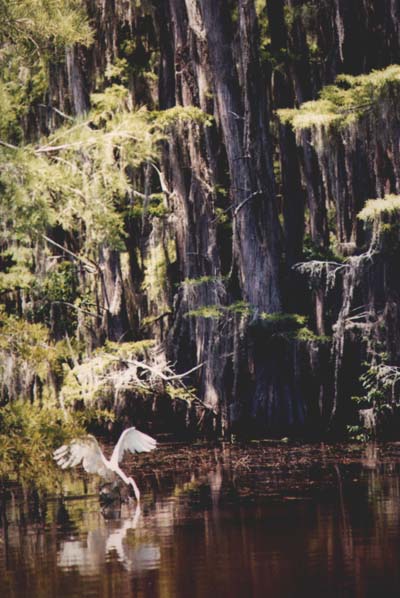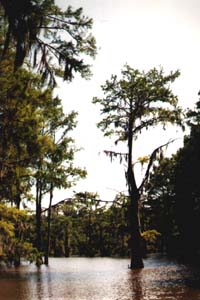She has always tried to possess man. She has always struggled against nature for her survival. Since the time Caddo Lake was formed, her battle has been one for possession: of man, and of nature. In the end, she will not allow men to possess her; she alone will possess those that thrive on her bounty.
She rose up, Indian lore claims, in the middle of the night as the sky god shook the earth in anger at a Caddo Chief. In fact, she probably was formed during the great earthquakes of the 18th and 19th Century. White explorers, however, credit her formation to the floods of the Great Raft: millions of fallen trees clogged the waterways of the Red River, flooding the land from Shreveport northwest to modern day Texarkana.
She first possessed the Caddo Indian. The Caddoans were a friendly, hospitable nation, whose greeting, "Tejas" (meaning friendly) became the name and motto for a republic, a territory, and a state. For half a century, the Caddo welcomed into their lands the Indian refugees from the eastern United States. The Alabama, the Coushatta, Creek, Kickapoo, and Delaware were just a few of the tribes that came to live on her shores and in her waterways. In 1835, the Caddo surrendered their home, selling the lake and surrounding lands to the United States. War and commercial activity soon arrived in the watershed of Caddo Lake.

Nestled in the area known as the "Neutral Ground" - where neither the laws of the Mexican Republic or the United States were adhered to - Caddo Lake became home to outlaws, counterfeiters, and pirates (most notably, Jean Lafitte). With the birth of the Texas Republic in 1836, law abiding citizens struggled to maintain land claims in the area. The Regulator-Moderator war, a fierce duel between the men who enforced the laws of the Republic, and those who enforced the enforcers, led to the murder of hundreds of men who tried to own the frontage of Caddo Lake.
Robert Potter, a North Carolina native, signer of the Texas Declaration of Independence, first Secretary of the Texas Navy, and a Texas Senator, was among the most infamous to die in her waters. Chased down by Regulators, he dove into the lake to escape. He was shot in the head as he surfaced for air. Potter's Point, on the northern edges of the Lake, is the site of his murder. Until he was re-interred in 1936, Colonel Potter overlooked the shores of Caddo Lake from his grave.
Robert Potter and his wife, Harriet Potter Ames (the Kishi Woman of Texas pioneer lore) helped bring civilization and commerce to the Caddo Lake Region. More than any other inhabitants, until the 20th Century, the kishi woman let the land possess her. (N.B. Harriet Potter Ames' story is told in the historical novel: "Love is a Wild Assault")

Steamboats ferried goods and settlers from Louisiana to Texas. Commerce thrived: the town of Jefferson sprang up in response to the movement of settlers into Texas. For a period of about two decades, Jefferson was the second largest port city in the South: second only to Galveston Port. Throughout the Civil War, the ferries of Caddo Lake carried Texas men east to fight their Yankee cousins.
|
In 1873, the last of the Great Raft of the Red River was removed, and Caddo Lake began her struggle for survival against the laws of nature. The flow of the Red River pulled water from the bayous of Caddo Lake, and her waters receded to an unnavigable depth. In her attempt to survive against nature, she offered forth mussels and pearls, in the hopes of bringing more men to her shores. The area once again began to thrive. Man tried once again to dominate her. He uncovered the East Texas Oilfield below her waters.

The Caddo Indians had known oil was there: they skimmed her surface for the oily grease that protected them from the mosquitoes. The early white settlers used the sludge to grease the axles of their wagons. In 1914, a dam was constructed to dry out the surrounding areas for oil exploration. The first water-borne drilling platform was built on the lake. She watched as man rushed once again to possess her and the oil that lay below her dark black waters. Man was there to stay. (N.B. Oil is still being pulled from the lake today.)
She was purchased by the State of Texas in 1933, and became a state park in 1934. The dam was rebuilt in 1971. She has become the "Walden Pond" of singer-musician Don Henley. Caddo Lake Institute, named in her honor, was formed to battle the international destruction and commercialization of wetlands.
Caddo Lake is a veritable Eden. She covers over 25,000 acres: half in Texas, half in Louisiana. Nestled between the Red River and the Sabine River basins, she is easily accessible from Shreveport, Dallas, and Little Rock.
Anglers cannot help but return time and again to fish her waters. Largemouth bass, white bass, channel catfish (some as large as 52lbs) and chain pickerel are plentiful. At first glimplse, the lake appears nothing more than a swamp - many a fisherman has been hypnotized and misoriented in her maze of bayous.

Alligators (as long as 12-15 feet), white tailed deer, armadillos, and eagles have all found natural habitat in Caddo Lake. (There are estimated to be at least 15 nesting pairs of Bald Eagles in the watershed) Occasional mussels speckle her sandy, shallow shores, offering remembrance to the days of the pearl camps in her sloughs.
Boaters and canoers spend days drifting on her tranquil waters. A steamboat ferries visitors along the lake, offering a glimpse of the vista adored by Harriet Potter Ames. Hikers, campers, and backpackers, awed by her 400 year old cypress trees draped with Spanish Moss, will find alternately rough and easy trails and forests to explore.
In the end, she has been victorious. Caddo Lake is, and will remain, a delicate balance between the ecosystem of nature and the ecosystem of civilization.
|

